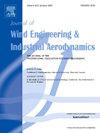飞行器底面与基座非定常尾迹空气动力学关系的研究
IF 4.9
2区 工程技术
Q1 ENGINEERING, CIVIL
Journal of Wind Engineering and Industrial Aerodynamics
Pub Date : 2025-07-30
DOI:10.1016/j.jweia.2025.106177
引用次数: 0
摘要
采用大涡模拟的方法,研究了在转速约为7.4×105处的方形汽车车身的非定常流场。该研究是在旋转的车轮和移动的地平面下进行的,结果与类似实验数据集的平均流场非常吻合。利用固有正交分解、谱固有正交分解和谱分析模型表面的时间分辨压力场来揭示尾迹和底流的时空相互作用。确定的突出的车身下流动特征是后轮之间的横向和流向运动以及来自前轮的更复杂的脱落相互作用。后尾流表现出主要的侧向扑动,并显示出与下车身侧向模式相关。这可以通过对车底和尾流结构的条件平均进一步看出,显示出同时的侧向偏置。这项研究证明了后轮到底盘的非定常流特征之间的联系,强调了在未来的车辆气动研究中考虑这些相互作用的重要性。本文章由计算机程序翻译,如有差异,请以英文原文为准。
Investigation of the link between vehicle underbody and base unsteady wake aerodynamics
The unsteady flow around a squareback automotive body at of approximately is investigated using a Large Eddy Simulation. The study is conducted with rotating wheels and a moving ground plane and is shown to be in strong agreement with the mean flow fields of similar experimental datasets. Proper Orthogonal Decomposition, Spectral Proper Orthogonal Decomposition, and spectral analysis of the time-resolved pressure fields on the model surfaces are used to reveal spatial and temporal interactions in the wake and underbody flow. The salient underbody flow features determined are lateral and streamwise motions between the rear wheels and a more complex shedding interaction from the front wheels. The rear wake exhibits a dominant lateral flapping motion and is shown to correlate to an underbody lateral mode. This is further seen through conditional averaging of the underbody and rear wake structures, showing a concurrent lateral bias. This study demonstrates a link between rear-wheel-to-base unsteady flow features, highlighting the importance of considering these interactions in future vehicle aerodynamic studies.
求助全文
通过发布文献求助,成功后即可免费获取论文全文。
去求助
来源期刊
CiteScore
8.90
自引率
22.90%
发文量
306
审稿时长
4.4 months
期刊介绍:
The objective of the journal is to provide a means for the publication and interchange of information, on an international basis, on all those aspects of wind engineering that are included in the activities of the International Association for Wind Engineering http://www.iawe.org/. These are: social and economic impact of wind effects; wind characteristics and structure, local wind environments, wind loads and structural response, diffusion, pollutant dispersion and matter transport, wind effects on building heat loss and ventilation, wind effects on transport systems, aerodynamic aspects of wind energy generation, and codification of wind effects.
Papers on these subjects describing full-scale measurements, wind-tunnel simulation studies, computational or theoretical methods are published, as well as papers dealing with the development of techniques and apparatus for wind engineering experiments.

 求助内容:
求助内容: 应助结果提醒方式:
应助结果提醒方式:


